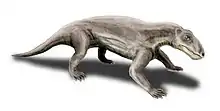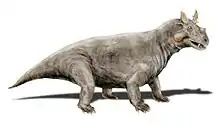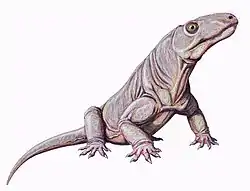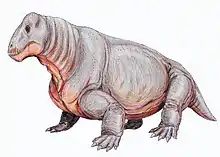Lende
Lende is an extinct genus of biarmosuchian from Malawi. It contains one species, Lende chiweta, first reported by Jacobs and colleagues[2] in 2005 and is a burnetiamorph – a group of biarmosuchians characterized by numerous bosses and swellings on the skull.[3] The type specimen was discovered in the early 1990s in the Permian Lower Bone Bed (B1) of the Chiweta Beds of Malawi, which are believed to correlate with the Cistecephalus Assemblage Zone of the South African Karoo Supergroup, the Usili Formation of Tanzania, and the Upper Madumabisa Mudstone of Zambia.[2][4] The holotype of the genus Lende is MAL 290, which comprises an almost complete skull and lower jaw.[1]
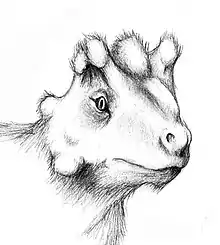
A reconstruction of L. chiweta
| Lende | |
|---|---|
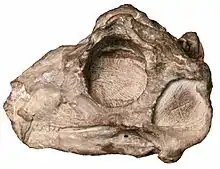 | |
| MAL 290, the holotype of Lende chiweta | |
| Scientific classification | |
| Kingdom: | Animalia |
| Phylum: | Chordata |
| Clade: | Therapsida |
| Suborder: | †Biarmosuchia |
| Clade: | †Burnetiamorpha |
| Genus: | †Lende Kruger et al. 2015[1] |
| Type species | |
| Lende chiweta Kruger et al. 2015[1] | |
References
- Kruger, Ashley; Rubidge, Bruce S.; Abdala, Fernando; Chindebvu, Elizabeth Gomani & Jacobs, Louis L. (2015). "Lende chiweta, a new therapsid from Malawi, and its influence on burnetiamorph phylogeny and biogeography". Journal of Vertebrate Paleontology. 35 (6): e1008698. doi:10.1080/02724634.2015.1008698.
- Jacobs, Louis L.; Winkler, Dale A.; Newman, Kent D.; Gomani, Elizabeth M. & Deino, Alan (2005). "Therapsids from the Permian Chiweta Beds and the age of the Karoo Supergroup in Malawi". Palaeontologia Electronica. 8 (1): 1–23. Lay summary.
- Carrano, Matthew (2006). Amniote Paleobiology: Perspectives on the Evolution of Mammals, Birds and Reptiles. Chicago, Illinois: University of Chicago Press. ISBN 0226094782.
- Sidor, Christian A.; Vilhena, Daril A.; Angielczyk, Kenneth D.; Huttenlocker, Adam K.; Nesbitt, Sterling J.; Peecook, Brandon R.; Steyer, J. Sébastien; Smith, Roger M. H. & Tsuji, Linda A. (2013). "Provincialization of terrestrial faunas following the end-Permian mass extinction". Proceedings of the National Academy of Sciences of the United States of America. 110 (20): 8129–8133. doi:10.1073/pnas.1302323110. PMC 3657826. PMID 23630295.
This article is issued from Wikipedia. The text is licensed under Creative Commons - Attribution - Sharealike. Additional terms may apply for the media files.
